We have already covered the correct procedure for approaching a junction; turning left at a junction and turning right at a junction.
This tutorial covers specifically ’emerging from a junction’ or emerging from a side road’. At and around junctions, statistics show that these particular road systems represent the most hazardous areas and it’s at junctions where the most accidents take place. Junctions pose a particular hazard to cyclists and motorcyclists.
With so many junctions varying drastically in terms of size, complexity, layout and with what the driver can see ‘visibility’, junctions are particularly challenging for novice drivers.
In fact year on year, the number one reason for driving test failures if a lack of proper observation at junctions (see the top 10 reasons for test failure each year for further information).
Most junctions aren’t particularly dangerous. Danger usually arises due to drivers not taking enough time to correctly assess the situation before emerging. This begins with the approach to the junction. Approach a junction using the MSPSL routine and approach slow enough to be able to assess if the junction is open or closed. This will allow you enough time to stop safely if you need to, or proceed without the need to stop at all.
An explanation on ‘open’ and ‘closed’ junctions can be found in the junctions tutorial. Detailed on this page are tips in avoiding frequently made mistakes during the practical driving test at hazardous junctions types.
Observation
The most important aspect of emerging from a junction is observation. Allow yourself at least enough time to look left and right, at least twice in both directions before emerging. Quite often something is missed that is seen on the second glance. This could be a cyclist or a speeding motorist for example.
Vehicle Blind Spots
Usually associated with mirrors, blind spots can occur in other areas of your vehicle. A-pillars are the upright pillars, or ‘posts’ either side of the front windscreen that attach your vehicle roof to the rest of your car. In the event a driver rolls their vehicle, these pillars need to be very strong, ensuring the roof stays where it is.
As a result, they can often be rather wide, making a blind spot. These blind spots may not seem like much of an issue, but to a driver not taking appropriate time to observe before emerging from a junction can result in an accident.
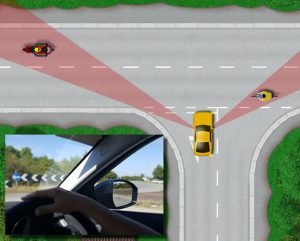
As can be seen by the A-pillar blind spot diagram where the red shaded area represents the blind spot area, a cyclist or motorcyclist can easily be obscured by an A-pillar. To avoid potential disaster, take a little more time to observe before emerging from a junction. For further information, see
Parked Vehicles at Junctions
A common issue for motorists emerging from junctions is dealing with badly parked vehicles. Badly parked vehicles create different hazards depending on where they’re parked.
As can be seen by the ‘Vehicles parked close to a junction’ image, the red shaded area represents the limited view for the driver of the green car. The driver is unable to see the red car traveling down the road, passing the parked vehicles.
If you are confronted by this situation, very slowly edge forward using the creep and peep technique, whilst quickly looking left and right. Continuously and very slowly pull forward until you can see the junction is safe to emerge from.
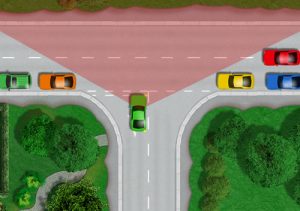
Always look and assess where vehicles are parked around junctions to determine how this will affect traffic flow and what action you need to take.
Another hazard when emerging from a junction are vehicles parked opposite the junction. Looking at the image ‘Vehicles parked opposite a junction’, we see the yellow car parked directly opposite the junction.
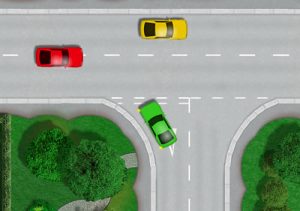
This is a highly hazardous place to park as it forces traffic in the same lane as the yellow car to move onto the opposite side of the road.
The problem here, is that drivers turning left out of the junction tend to focus their observation to the right as this is the direction where they need to give way to traffic. The driver of the green car might not see the red car whilst emerging from the junction till it’s too late.
Junctions on a Bend
Some junctions are located on bends, where the minor road meets the major road. The minor road may join the major road with use of give way road markings and sign, or if the junction is particularly hazardous, a STOP sign and line may be in place (see inset image of ‘Junctions on bends’.
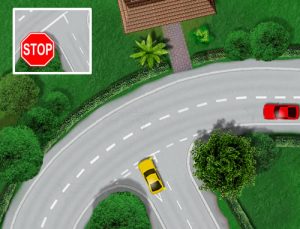
Junctions on bends are hazardous for vehicles on either road. If driving on the major road, observe advance signs warning of a junction on a bend. Slow down and be prepared for vehicles entering your road from a side road. See junction road signs for further information.
If driving driving on the minor road, your vision of the major road will be restricted. Edge forward to the junction line as close as possible to gain the best view before emerging. Hazardous junctions such as this will almost certainly require stopping before emerging, and if there’s a STOP sign, it is a legal requirement to do so.
Slow Roads Joining Fast Roads
A slow minor road joining a high speed major road can be challenging, particularly for novice drivers. New drivers can struggle to judge the speed of traffic when attempting to join a new road.
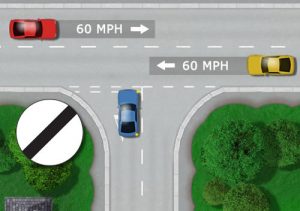
Look for signs that may indicate a speed limit change on the new road. If you see a national speed limit sign (white with black diagonal stripe) and the road you intend on joining is single carriageway, the speed limit is 60 mph.
If you are unsure what speed a vehicle is traveling at and whether it is safe to emerge or not, don’t risk it. Wait only for a safe gap that you’re confident for entering the new road.
When entering a high speed road, following vehicles can catch up quickly. As soon as entering the new road, check your interior mirror and apply the accelerator accordingly.
Junctions on a Hill
Downhill junctions generally don’t cause too much concern as the car can be secured simply with the brake pedal or handbrake. It’s uphill junctions that put the fear into many drivers either due to stalling over the junction line in the path of an oncoming vehicle, or rolling backwards into the car behind.
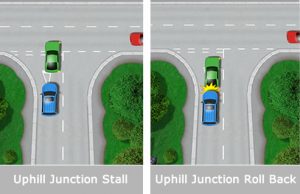
Essentially this is all to do with clutch control. If you need to stop at the junction, select first gear and apply the handbrake. Then find the clutch bite point and give a little gas (accelerator). If you don’t find the bite point, the car will roll backwards regardless of how much gas you apply once the handbrake has been released.
The steeper the uphill gradient, the more gas you’ll need. Too little gas will result in a stall and releasing the clutch pedal too quickly can also result in a stall. Junctions on a hill take practice, so find a quiet road to do just that. For further advice, see
Junctions on Dual Carriageways
Dual carriageways are high speed, 70 mph primary routes and a junction entering a dual carriageway will almost certainly involve a slip road. Novice or nervous drivers will often travel down the slip road too slowly. The correct procedure however is to use the slip road as to gain sufficient speed that’s similar to that of traffic on the dual carriageway. By doing so, you will merge safely into traffic and not cause other drivers to slow down. For a full guide on using dual carriageways, see:
TUTORIALS RELATED TO JUNCTIONS
- Road junctions
- Turning left at a junction
- Turning right at a junction
- Box junction
- Staggered junction
- Y Junctions
- D Junctions
- Junction lines
- Junction signs
- Creep and peep
- What are major and minor roads
